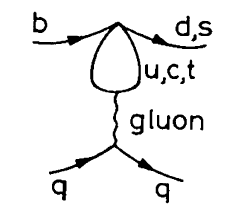
 Home Home |
 For authors For authors |
 Submission status Submission status |
 Current Current
|
 Archive Archive
|
 Archive
(English) Archive
(English)
|
 Search Search |
M.A. Shifman
School of Physics and Astronomy, University of Minnesota, Minneapolis, MN
55455, USA
William I. Fine Theoretical Physics Institute, University of Minnesota,
Minneapolis, MN 55455, USA
The penguin mechanism or penguin graphs present a class of Feynman diagrams which turned out of paramount importance for understanding weak flavor changing decays. While in the original paper in which they were introduced [1] only strange particle decays were considered, the idea was generalized to a large range of other applications, for instance, CP violating processes in B-meson decays, electroweak penguins, and many others. (The term penguin graphs was suggested by John Ellis later, see below.) The first developments were reported by the authors in [2]. The B-physics “penguins” are sensitive to new physics, especially those rare decays that are dominated by “penguin diagrams.” They were directly observed in 1991 and 1994 by the CLEO collaboration.
“Penguins started to fly” [3] in high-energy physics in 1974. It was the very beginning of the quantum chromodynamics (QCD) era. We started to study interplay between the weak and strong interactions in 1973. The most perplexing issue in the strange particle decays was a seemingly unexplainable enhancement of the ∆I = 1/2 amplitudes in the kaon and baryon decays compared to the ∆I = 3/2 amplitudes. This mystery known under the name of “∆I = 1/2 rule” had been discussed by J. Schwinger as early as in 1964. The advent of QCD gave a new hope for explanation of this phenomenon. The publication [4] of Gaillard and Lee, which reached ITEP in a preprint form, provided us with a stimulating impetus. These authors noted that gluons act differently on the ∆I = 1/2 and ∆I = 3/2 amplitudes, with a tendency to enhance the former and suppress the latter [5]. This tendency was not enough, however, to explain the effect. When we discovered the penguin graphs and realized that they can appear only in the ∆I = 1/2 part of the strange quark decay amplitudes we understood that we were on the right track. Special chiral features inherent only to penguins led to the successful completion of the ∆I = 1/2 rule derivation (for a review see [3]). This result was reported in summer of 1974 at an international conference.
In four decades that elapsed the march of the penguin diagrams in various flavor-changing processes was quite remarkable. Certainly, we could not anticipate this when we submitted the first paper to JETP Letters. At that time the newly discovered (SVZ) diagrams did not look like penguins. They
were distorted to look penguin-like by John Ellis.

The SVZ graph in John Ellis’ “penguin” rendition.
Here is John’s story which travels from one website to another (originally published in [6]): “Mary K. [Gaillard], Dimitri [Nanopoulos] and I first got interested in what are now called penguin diagrams while we were studying CP violation in the Standard Model in 1976. The penguin name came in 1977, as follows. In the spring of 1977, Mike Chanowitz, Mary K. and I wrote a paper on GUTs predicting the b quark mass before it was found. When it was found a few weeks later, Mary K, Dimitri, Serge Rudaz and I immediately started working on its phenomenology. That summer, there was a student at CERN, Melissa Franklin who is now an experimentalist at Harvard. One evening, she, I and Serge went to a pub, and she and I started a game of darts. We made a bet that if I lost I had to put the word penguin into my next paper. She actually left the darts game before the end, and was replaced by Serge, who beat me. Nevertheless, I felt obligated to carry out the conditions of the bet. For some time, it was not clear to me how to get the word into this b quark paper that we were writing at the time. Then, one evening, after working at CERN, I stopped on my way back to my apartment to visit some friends living in Meyrin, where I smoked some illegal substance. Later, when I got back to my apartment and continued working on our paper, I had a sudden flash that the famous diagrams look like penguins. So we put the name into our paper, and the rest, as they say, is history.”
References
[1] A.I. Vainshtein, V.I. Zakharov, M.A. Shifman, Pisma ZhETF 22, 123 (1975) [JETP Lett. 22, 55 (1975)].
[2] M. A. Shifman, A. I. Vainshtein and V. I. Zakharov, Nucl. Phys. B120 316 (1977) Non-leptonic decays of K-mesons and hyperons. ZhETF 72 1275 (1977) [JETP 45 670 (1977)].
[3] A. I. Vainshtein, Int. J. Mod. Phys. A 14, 4705 (1999) [hep-ph/9906263].
[4] M.K. Gaillard and B. Lee, Phys. Rev. Lett. 33, 108 (1974).
[5] Mary K. Gaillard, A Singularly Unfeminine Professions, (World Scientific, Singapore, 2015), p. 59.
[6] M. Shifman, ITEP Lectures in Particle Physics, (World Scientific, Singapore, 1999), Vol. 1, p. x [hep-ph/9510397].
Download as PDF